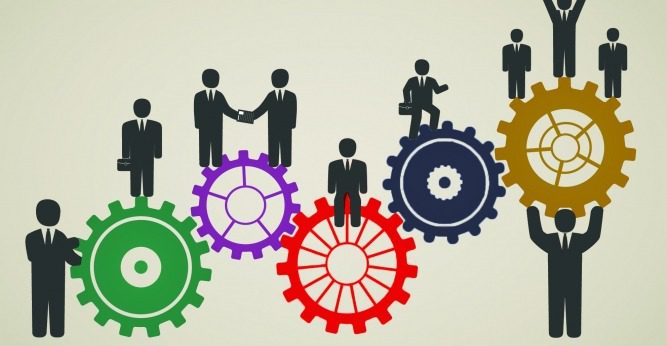Today, Learning & Development (henceforth, to be referred as L&D in this article) Intervention in Business is not only a priority, but a “Mandate”, irrespective of the shape, size, strength of the business and the industry it belongs to. We all are well aware that today’s business world is trade marked by ‘Volatility’, ‘Uncertainty’, ‘Complexity’ and ‘Ambiguity’. With all these external adversities, the constant endeavor of a business is to strive towards survival, sustenance and success for both short run as well as for long run. In today’s age, almost everything is replicable which includes but not limit to product, service, technology and resource. The only exception is the people factor, which always remain unique in nature. Nowadays, people are considered as capital over resources and the new term ‘Human Capital’ has been coined therefore. Organizations which focus on Human Capital and their development, enhance their organizational performance by manifolds.
Some Major Challenges:
Today, most of the businesses are facing some roadblocks towards their growth. They are-
- Increasingly competitive business environment
- Constant evolution and consequently, rapidly changing technology and business model
- Wide dispersal of organizational existence, across the globe
- Scarcity of skilled workforce to comply with this constant change
- Void in natural Leadership
Source of Shortfall:
Now if we attempt to find out the rationale, the most obvious question – which primarily comes in our mind – is: “is it due to the under performance of Indian Academia”? But if we dive deep, it can be revealed that Education Industry alone cannot be blamed. The root is embedded in a much deeper level. It is the ‘Dynamic Environment’ being impacted by the rapid change in ‘Technologies’ and ‘Customer Needs & Wants’. India is a knowledge driven economy. Talent shortage – especially in customer facing roles – has detrimental impact on the growth of the business.
Indian Business Mind:
The overall L&D spend in India is way lower than that of developed countries. However,it is foreseen that, by the Yr. 2028, India is expected to hold the global rank of being third largest economy. To correspond with this and to combat with the previously mentioned challenges, almost 89% of the organizations in India are expected to increase in their investment in terms of time and effort for the development of their critical workforce, going forward. In order to ensure that Indian businesses can compete at the global stage, L&D strategies need to be put in place to plug the skill-gap of the workforce.
Evolution of L&D:

Learning and Development Intervention in Corporate:
Today’s scenario pinpoints a shift going to happen from stand-alone approach to a comprehensive one-stop shopping approach, to meet the divergent learning needs. Organizations are increasingly putting preference on value added services such as assessment, curriculum design, return on investment (ROI) criteria compared to previously emphasized training delivery. A scarcity of true-n-natural leadership potential pushed the focus on leadership training program over simple technical up-skilling.
Facilitators of L&D Intervention:
- Knowledge driven economy
- Optimized IT support with modern and faster internet based web connection
- Usage of Mobile-app in Learning
- Self-paced learning
- Ease of access:
- Remote access
- Anytime access
- Customized and personalized learning
- Implementation of interventions, other than training
- Application of blended model, even for a single module
- Multi-language support
Some Special Mentions:
- Coaching / Mentoring – It will continue to be a key tool for executive and leadership development. Organizations expect to see clear success criteria as a part of any intervention / engagement. ROI (Return on Investment) is going to be under spot light.
- Globalization will shape more leadership programs – These days many organizations have had global dimensions and therefore leadership qualities, integrated with proficient cross-culture management, is of utmost importance.
- Re-emergence of basic Skills Training –Due to volatility in the business environment and budget constraints, programs devoted to developing basic skills often take the back-seat. Even though organizations will continue to keep a special eye on Leadership skill building, basic skills training will re-emerge. Specific and highly focused short term module with creative approach will put it back in place.
- L&D Intervention enhances longer association of employees with their employers–Today’s VUCA world (Volatile, Uncertain, Complex and Ambiguous) has put both employer and employee in a restless condition. High attrition rate has become an evident consequence. To combat against this, employee development-n-growth strategy is the major weapon for the companies. Only this factor can keep the employees glued to their organization for a longer period of time. This will save the expense and effort of the business towards rehiring and retraining for the same profile over and over. And this will have favorable impact on their bottom line.
Shift in L&D Intervention Trend:
- E-Learning: This methodology is in its nascent stage in India, compared to the developed nations such as US and UK. However, it’s growing in popularity. Indian companies have made and continue to make significant attempts to integrate this methodology for their Talent Development.
- On-the-job Training with the aid of ‘Audio-Visual Content’: This intervention is increasingly being used in India. Platforms such as external conferences, workshops & events, and classroom based training are slowly losing their prominence owing to higher recurring cost.
- Growth of MOOC (Massive Open Online Course):
- A few renowned US based MOOCs are – Coursera, EdX and Udacity. They register quite high number of non-US based enrollments from India.
- A large number of Indian Universities and Colleges are these days partnering with MOOCs.
- From Indian perspective, NPTEL (National Program on Technology Enhanced Learning) is one such example.
- It is an initiative by seven (7) IITs (Indian Institute of Technologies) and IISc, Bangalore (Indian Institute of Science) to create course in the field of engineering, science and other associated arena.
- Indian students are increasingly opting for MOOCs due to :
-
- A wide assortment of courses
- Personalized learning experience
- High quality content
- Economic reason and affordability
- Provision of premium international education at one’s reach and convenience
- Freemium and paid model- MOOC Provider offers a complimentary module, along with paid modules for advanced levels.
4. Flipped Classroom Model: It is the blended learning strategy with the intention of greater learner involvement. It can be equated as the pedagogies such as active learning, peer instruction, case-based or problem-based learning which requires students to prepare learning before they meet and engage with peers in purposeful activities with the sole intention of mutual learning. Here the learning instruction moves from group learning space to individual learning space. Thus, transforming the group space into a dynamic and interactive learning environment. This methodology increases learners’ onus towards their own learning and subsequent implementation. The four pillars of flipped methodology are :
- Flexible environment (F)
- Learning culture (L)
- Intentional content (I)
- Peers as educators (P)
In traditional learning, lower level of learning (such as remembering and understanding) is happening in the class; while students are usually left to work on activities that involve higher level of learning outside the classroom. However, in flipped classroom model, learning is flipped. Learners can finish the lower level of cognitive learning before the actual learning happens. And, during the session of actual learning, they can engage in higher cognitive levels of learning with peers / educators. This corresponds to the below mentioned flipped pyramid.

5- M-Learning / Mobile Learning: This methodology involves learning through mobiles, tablets, hand-held computers etc. It has certain benefits:
- Access from anywhere to learning material, even when on the go.
- Ease and convenience in all respect including self-paced approach.
- Retention of learning is much powerful, as it gives relevant information as nuggets. And, that too can be referred from virtually anywhere to refresh the memory
- Overcoming learners’ resistance is a great value attributed by this methodology. The busy schedule of high profiled leadership professionals prefer this option over a long-engaged one.
6-Social Learning: It is a collaborative learning with and from others. In this methodology, learning happens through social influence. This is the concept taken from psychological theory and was pioneered by American Psychologist – Albert Bandura. As an instance, we can say, children learn and adopt many behaviors like sharing, aggression, cooperation, social interaction, gratification, delay in gratification etc. These days, social media imparts greatly to such kind of learning. These days people spend most of their free times with social media websites. Parents keep seeing their sons / daughters glued to their phones and get frustrated. But, this gives an opportunity to think differently. This platform can be used very innovatively as a learning media. Naming a few methodologies that could be adopted, are:
- Creating face book group for learning purpose
- Usage of blogging for any sort of assignments
- Usage of twitter / Facebook etc. to highlight important learning elements through hashtags (#)
- Usage of Pinterest for pinning learning resources
- Usage of YouTube for flipped classroom concept
Social media platforms are useful when both educators and learners know how to use them.
The Last Word: As we initiated our discussion saying “contribution of Learning & development intervention is going to takean epic shape in future days”, we have seen how different intervention styles have been emerged to correspond and resonate with the business needs reasonably, thus making a perfect ally with the business. It’s the time to think differently and innovatively to extract optimum benefits for both business and the employees, by making a symbiotic bond. And, this bond can be created through the development of workforce to bridge the gap between their existing skill level and the desired competency level to give business the steady upward stroke. L&D, here, partners with business and makes a prominent positive impression on business revenue and competitive advantage.
 Author- Jayati Mukherjee, Founder and Career-Coach, CareerViPla – Visual Planner of Your Career. She has over 17+ Yrs. of professional experience with diverse scope worked with German MNC Siemens Limited, Last assignment with Siemens Limited was as Manager – Human Resources Certified Talent Management. She has earned professional qualification from XLRI with 97% score, certified emotional intelligence professional from IIT Kharagpur, with 88% score & Secured place in Top 2% Achievers Post Graduate Diploma in Management (Human Resources) Master of Science in Biochemistry and Secured the position of 1st Class 1st Certification in Public Speaking from Xaviers Institute of Communication (XIC) Member of Toast Masters Club – A Place of Leadership &Communication Skill Enhancement
Author- Jayati Mukherjee, Founder and Career-Coach, CareerViPla – Visual Planner of Your Career. She has over 17+ Yrs. of professional experience with diverse scope worked with German MNC Siemens Limited, Last assignment with Siemens Limited was as Manager – Human Resources Certified Talent Management. She has earned professional qualification from XLRI with 97% score, certified emotional intelligence professional from IIT Kharagpur, with 88% score & Secured place in Top 2% Achievers Post Graduate Diploma in Management (Human Resources) Master of Science in Biochemistry and Secured the position of 1st Class 1st Certification in Public Speaking from Xaviers Institute of Communication (XIC) Member of Toast Masters Club – A Place of Leadership &Communication Skill Enhancement









